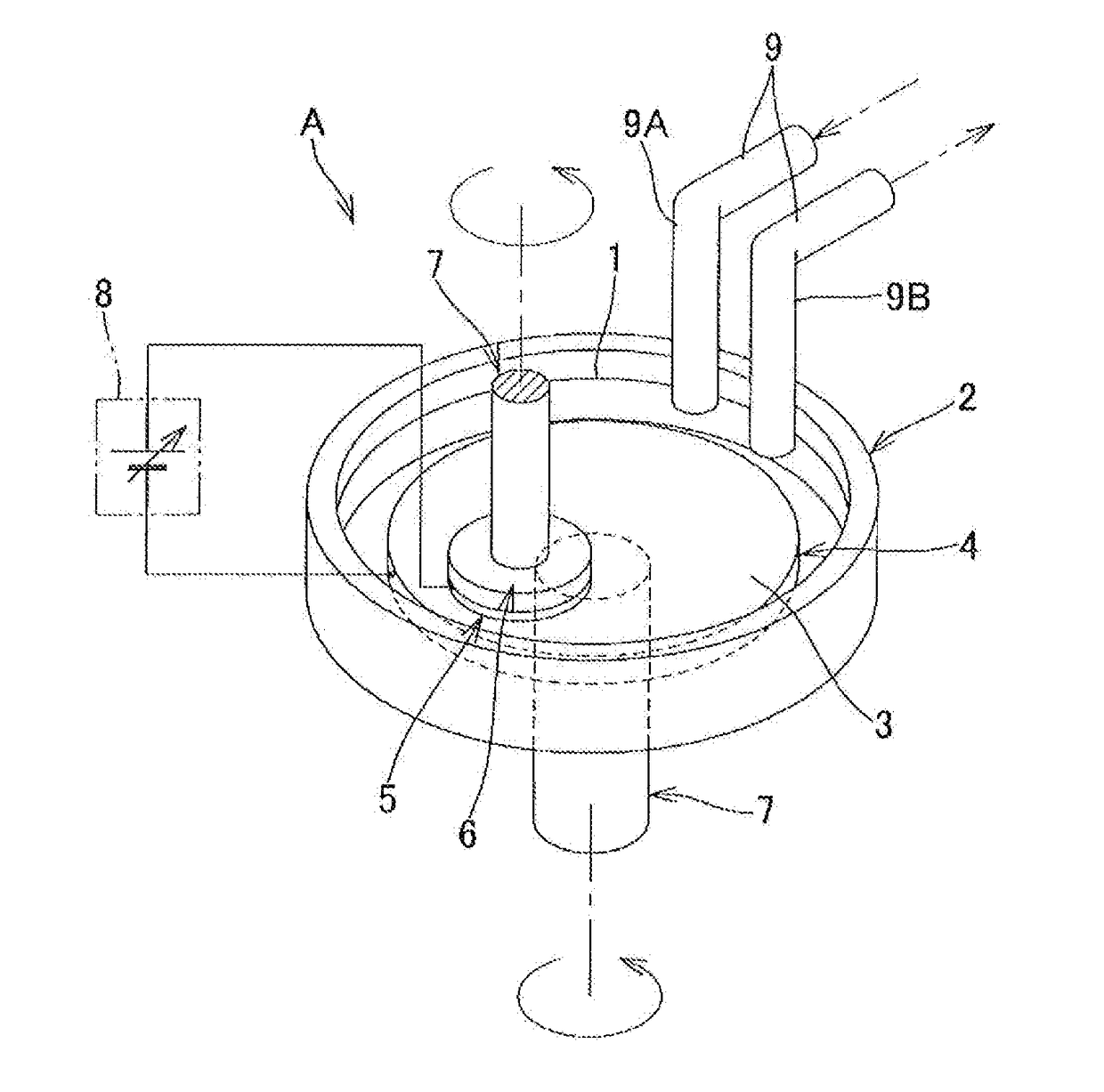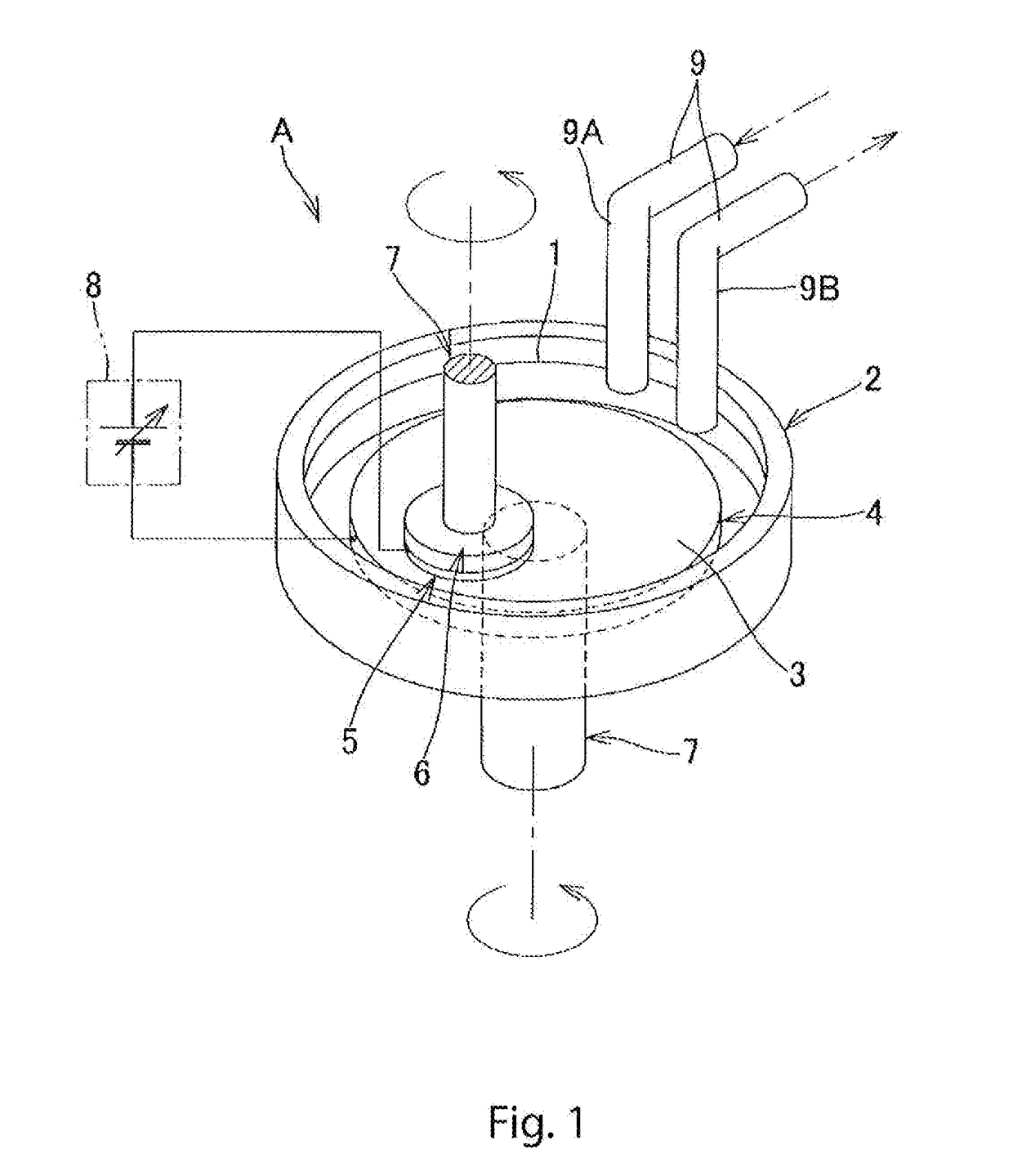Method for processing wide-bandgap semiconductor substrate and apparatus therefor
a technology of wide-bandgap semiconductor and processing method, which is applied in the direction of electrical apparatus, semiconductor devices, basic electric elements, etc., can solve the problems of unstable supply of cerium, high cost of treating a polishing liquid, and damage to the surface, so as to promote hydrolysis of oxide film, promote hydrolysis of workpiece, and excellent compatibility with a clean room
- Summary
- Abstract
- Description
- Claims
- Application Information
AI Technical Summary
Benefits of technology
Problems solved by technology
Method used
Image
Examples
example 1
[0067]Next, FIGS. 4 to 9 show the result of experimentally processing of SiC and GaN by the processing apparatus A using Pt as a catalytic substance forming a processing reference plane. For the processing reference plane, a rubber pad was used, in which a Pt film in a thickness of 100 nm was formed on the surface of the rubber pad, and the rubber pad was held on the surface of the rotating platen. The potential of the catalyst was not adjusted and processing was all performed at a rest potential. Surfaces before and after planarization were observed using a phase shift interference microscope (NewView made by Zygo Corporation) and an atomic force microscope (AFM), and the processing characteristics were evaluated.
[0068]FIG. 4 shows experimental processing using a two-inch n-type 4H—SiC (0001) on-axis wafer. In the processing conditions, the catalyst was Pt, the processing liquid was ultrapure water, the processing pressure was 400 hPa, and the rotational speed was 10 rpm. FIG. 4(a)...
example 2
[0076]Next, the controllability of processing speed was checked using the local processing apparatus C. First, the dependence of the processing speed on the processing pressure and the dependence of the processing speed on the rotational speed were checked using a 4H—SiC substrate. FIG. 11 shows the dependence on the processing pressure. FIG. 12 shows the dependence on the rotational speed. The dependence on the processing pressure was checked under the processing conditions in which the catalyst was Pt, the processing liquid was pure water, the processing pressure was 100 to 1,000 hPa, and the rotational speed was 10 rpm. The dependence on the rotational speed was checked under the processing conditions in which the catalyst was Pt, the processing liquid was pure water, the processing pressure was 400 hPa, and the rotational speed was 5 to 25 rpm. The potential of Pt is a rest potential. Only an elliptic region, with which Pt was brought into contact, was processed. The maximum dep...
example 3
[0093]Lastly, the dependence of the processing speed on a catalyst was checked using catalytic substance balls 36 formed with various catalytic metals. A processing target is a 4H—SiC (0001) wafer. In the processing conditions, the catalysts were various metals, the processing liquid was pure water, the contact pressure was 2,000 hPa, and the rotational speed was 24 rpm. The potential of the catalytic metal was a rest potential. For a catalytic metal, Ni, Pt, Cu, and Au were tested. Each of the catalytic metals was formed in a film on the surface of a rubber ring by sputtering vapor deposition. The result is shown in FIG. 21.
[0094]Ni achieves the processing speed 13 times the processing speed of Pt. It can be considered that the processing speed can be further improved depending on the selection of catalytic substances. Also in GaN (0001), a similar tendency was observed in the dependence of the catalytic metal on the processing speed. In the present invention, water is basically us...
PUM
 Login to View More
Login to View More Abstract
Description
Claims
Application Information
 Login to View More
Login to View More - R&D
- Intellectual Property
- Life Sciences
- Materials
- Tech Scout
- Unparalleled Data Quality
- Higher Quality Content
- 60% Fewer Hallucinations
Browse by: Latest US Patents, China's latest patents, Technical Efficacy Thesaurus, Application Domain, Technology Topic, Popular Technical Reports.
© 2025 PatSnap. All rights reserved.Legal|Privacy policy|Modern Slavery Act Transparency Statement|Sitemap|About US| Contact US: help@patsnap.com



